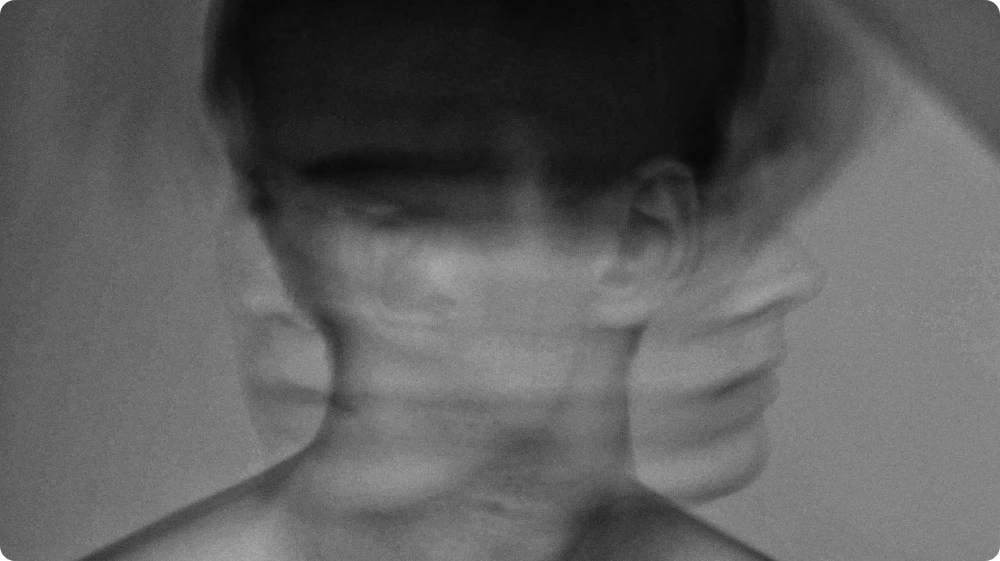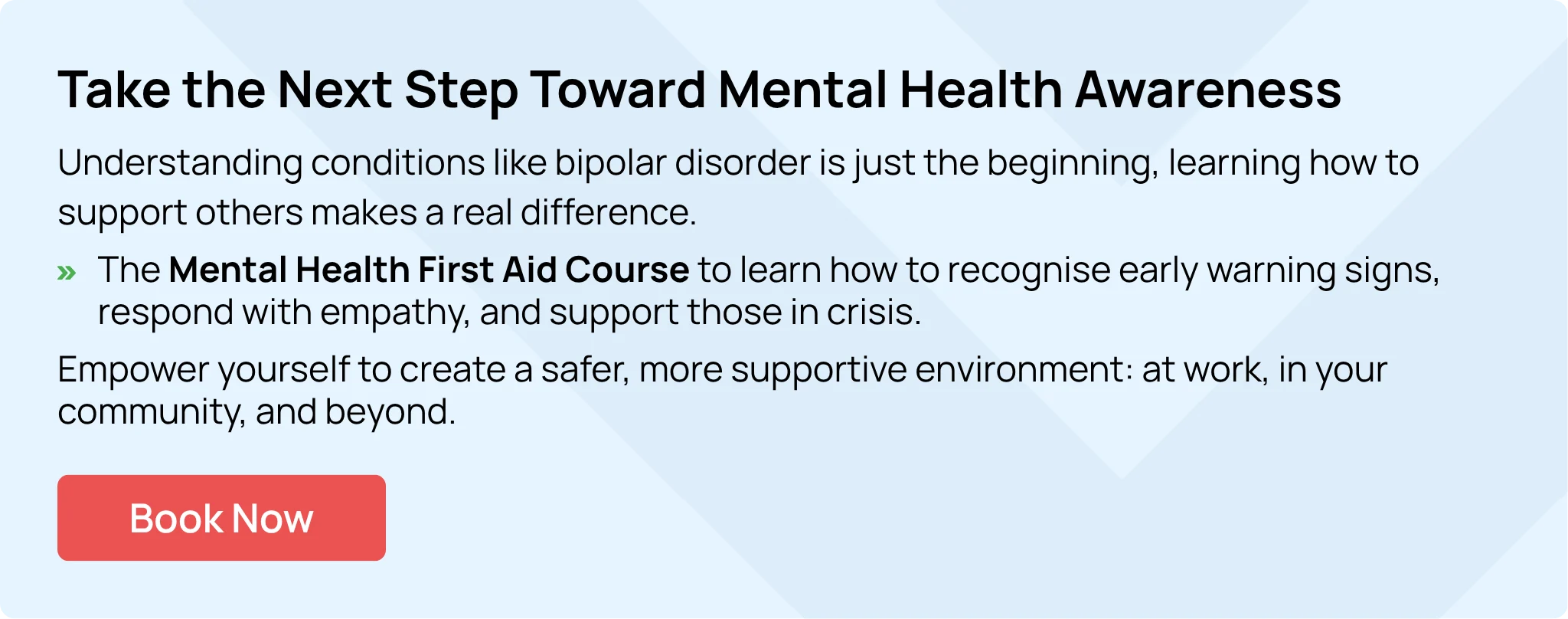
We all experience mood changes, feeling cheerful one moment and down the next — which is a regular part of life. But for someone living with bipolar disorder, these emotional changes are much more intense and longer-lasting.
This condition goes beyond everyday ups and downs, causing dramatic shifts in energy, thinking, and behaviour that can affect every aspect of life.
Bipolar disorder is a mental health condition that causes extreme mood swings, from emotional highs (mania or hypomania) to deep lows (depression). Although these shifts can be challenging to manage, with the proper treatment and support, people can live stable, fulfilling, and meaningful lives.
What Is Bipolar Disorder?
Bipolar disorder, also known as manic depression, is a mental health condition that causes significant shifts in mood, energy, and activity levels. People with this condition experience episodes of emotional highs called mania or hypomania, and periods of deep lows known as depression.
During a manic episode, a person may experience unusually high energy levels, speak rapidly, sleep very little, and take impulsive actions, such as overspending or taking unnecessary risks. While these feelings might seem positive at first, they can quickly become overwhelming and lead to serious consequences.
In contrast, a depressive episode brings intense sadness, low energy, and a loss of interest in activities once enjoyed. These emotional changes go far beyond regular ups and downs, often affecting relationships, work, and daily life.
Recognising the Symptoms of Bipolar Disorder

The symptoms of bipolar disorder can vary from person to person, depending on the type and severity of the condition. Episodes may include manic, hypomanic, or depressive states — each with its own distinct pattern.
Symptoms of Mania or Hypomania
- Feeling unusually excited, energetic, or “on top of the world”
- Talking more or faster than usual
- Needing very little sleep without feeling tired
- Acting impulsively or making risky decisions
- Having racing thoughts or becoming easily distracted
- Feeling overly confident or powerful
Symptoms of Depression
- Feeling sad, hopeless, or empty
- Losing interest in activities once enjoyed
- Feeling tired or low in energy
- Sleeping too much or having trouble sleeping
- Struggling to concentrate or make decisions
- Experiencing feelings of guilt or worthlessness
Key Signs You Shouldn’t Ignore
Recognising the early signs of bipolar disorder can make a significant difference in seeking timely help. While mood changes are common in everyone, people with bipolar disorder experience these shifts more frequently and with greater intensity.
Key signs to look out for include:
- Sudden bursts of energy or irritability followed by periods of profound sadness
- Sleeping very little without feeling tired
- Speaking rapidly or having racing thoughts
- Engaging in risky behaviour such as overspending or impulsive decisions
- Withdrawing from friends, work, or daily activities during low moods
If these signs persist or interfere with everyday life, it’s essential to reach out to a mental health professional. Early support can help manage symptoms and prevent episodes from worsening.
What Causes Bipolar Disorder?
The exact cause of bipolar disorder is not fully understood, but research points to a combination of genetic, chemical, and environmental factors.
Genetic influence: Bipolar disorder can run in families. Having a close relative with the condition increases the risk, although not everyone with a family history of the condition will develop it.
Chemical imbalance: Changes in the brain’s chemical messengers, known as neurotransmitters, can affect mood regulation and contribute to mood swings.
Sleep problems: Disrupted or irregular sleep patterns are known to affect mood and may worsen symptoms.
Environmental factors: Life events and circumstances can trigger or worsen mood episodes. Stressful experiences such as trauma, significant life changes, or prolonged stress may act as triggers in individuals who are already predisposed to bipolar disorder. Stress and irrational fears often heighten anxiety levels, as seen in conditions like the fear of fire, which can intensify emotional responses and trigger mood changes.
Exploring the Different Types of Bipolar Disorder
Bipolar disorder is not a single condition; it includes several types, each with its own patterns of mood changes. Understanding these types can help in recognising symptoms and the challenges individuals may face.
Involves at least one episode of mania that lasts a week or requires hospital care. Depressive episodes usually occur too and may last for weeks. The mood swings are intense and can affect daily functioning.
Characterised by recurring depressive and hypomanic episodes. Hypomania is a milder form of mania that doesn’t cause significant disruption, but the depressive episodes can be severe and long-lasting. Understanding the distinction between mania and hypomania helps identify the subtle variations in energy levels and behaviour that define different bipolar types.
A milder version of bipolar disorder involving ongoing mood fluctuations for two years or more. Though less severe, cyclothymia can still interfere with relationships, work, and overall quality of life.
- Other Specified and Unspecified Bipolar Disorders:
Some people experience bipolar-like symptoms that do not neatly fit into the categories above. These may include irregular mood episodes or mixed symptoms, but they still significantly impact daily functioning and emotional well-being.
How Is Bipolar Disorder Treated?
Treatment for bipolar disorder usually involves a combination of approaches tailored to each individual. The main goal is to manage mood episodes, reduce their severity, and improve daily functioning.
Psychotherapy, such as cognitive-behavioural therapy (CBT), interpersonal therapy, or family therapy, can help individuals cope with symptoms and understand triggers. Therapeutic approaches also address thinking patterns such as catastrophising, where minor concerns are perceived as overwhelming problems, increasing emotional distress.
Lifestyle adjustments, including maintaining a consistent sleep schedule, engaging in regular exercise, and maintaining a balanced diet, play a significant role in reducing mood swings.
Poor sleep quality or recurring stress dreams can indicate unresolved tension, which can impact emotional balance and overall mental health.
Education about the condition and participation in support groups empower both individuals and families, creating a strong support network. Effective treatment often requires collaboration with psychiatrists, therapists, and support systems to develop a holistic and sustainable plan.
Medications And Professional Support
Medication plays a central role in managing bipolar disorder, often combined with therapy and lifestyle changes. Commonly prescribed medications include mood stabilisers, antipsychotics, and sometimes antidepressants, depending on the individual’s symptoms and type of bipolar disorder.
It’s essential to work closely with a psychiatrist to find the proper medication and dosage, as responses can vary. Professional support, including regular check-ins with mental health specialists, ensures that treatment remains effective and adjustments are made when necessary. Combining medication with therapy and a supportive environment significantly improves long-term outcomes.
Living Well with Bipolar Disorder
Living well with bipolar disorder requires a combination of self-awareness, healthy habits, and support. Maintaining a consistent daily routine and healthy sleep patterns can help keep mood swings in check, while practising stress management techniques such as mindfulness or relaxation exercises provides additional stability.
Regular physical activity and a balanced diet contribute to overall well-being, and avoiding substances like alcohol or recreational drugs helps prevent mood disruptions. Building a support network, including family, friends, or peer groups, offers emotional support and understanding. By adopting these strategies, individuals with bipolar disorder can lead balanced, fulfilling, and productive lives.
When To Reach Out For Help
It’s essential to seek help when symptoms of bipolar disorder interfere with daily life or become overwhelming. Early intervention can prevent episodes from worsening and improve long-term outcomes.
Reach out to a mental health professional, such as a psychiatrist, psychologist, or therapist, for assessment and guidance. In urgent situations, contacting emergency services or helplines is essential for safety. Recognising when support is needed and taking action are key steps toward stability and well-being.

Conclusion
Bipolar disorder is a complex but manageable mental health condition. Recognising symptoms early, understanding the different types, and seeking appropriate treatment can make a significant difference. Combining therapy, medication, lifestyle adjustments, and support networks empowers individuals to live fulfilling lives. With the proper care and strategies, people with bipolar disorder can maintain stability, pursue their goals, and lead meaningful lives.
FAQs
What is bipolar disorder?
Bipolar disorder is a mental health condition characterised by extreme mood swings, including emotional highs (mania or hypomania) and lows (depression). These changes affect energy levels, behaviour, and daily functioning.
How is bipolar disorder different from regular mood swings?
Unlike regular mood changes, bipolar disorder involves intense and long-lasting episodes that can disrupt work, relationships, and everyday life.
What are the main types of bipolar disorder?
The main types include:
- Bipolar I Disorder: Severe manic episodes often followed by depression.
- Bipolar II Disorder: Hypomanic episodes (less intense than mania) along with depression.
- Cyclothymic Disorder: Milder mood swings over at least two years.
- Other Specified/Unspecified Bipolar Disorders: Symptoms that don’t fully match the above types but still affect daily life.
What causes bipolar disorder?
The exact cause isn’t fully understood, but it is linked to a combination of genetic, biological, and environmental factors. Family history, differences in brain structure and neurotransmitters, and stressful life events can all contribute to the development of depression.
What are manic episodes like?
During a manic episode, a person may feel overly energetic, euphoric, or irritable, babble, sleep very little, and engage in impulsive or risky behaviours. Mania can affect decision-making and relationships.







